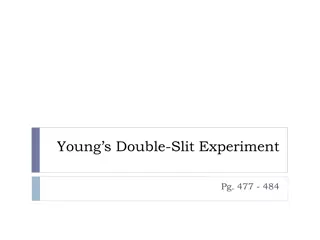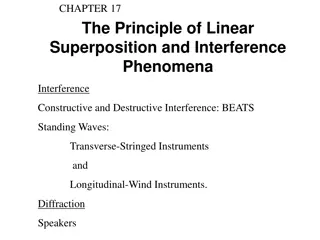Exploring Wave Interference in Physics: Superposition, Constructive, and Destructive Interference
Delve into the fascinating world of wave interference in physics, from understanding the concept of superposition to identifying constructive and destructive interference patterns. Discover how light waves interact through different paths and sources to create coherent or incoherent light. Explore the principles of interference through double-slit experiments and applets, shedding light on the behavior of waves in various scenarios.
Download Presentation

Please find below an Image/Link to download the presentation.
The content on the website is provided AS IS for your information and personal use only. It may not be sold, licensed, or shared on other websites without obtaining consent from the author.If you encounter any issues during the download, it is possible that the publisher has removed the file from their server.
You are allowed to download the files provided on this website for personal or commercial use, subject to the condition that they are used lawfully. All files are the property of their respective owners.
The content on the website is provided AS IS for your information and personal use only. It may not be sold, licensed, or shared on other websites without obtaining consent from the author.
E N D
Presentation Transcript
Physics 1161: Lecture 20 Interference textbook sections 28-1 -- 28-3
Superposition ConstructiveInterference +1 t -1 + +1 In Phase t -1 +2 t -2
Superposition Destructive Interference +1 t -1 + +1 Out of Phase t 180 degrees -1 +2 t -2
Which type of interference results from the superposition of the two waveforms shown? 1. Constructive 2. Destructive 3. Neither 1.5 1 0.5 0 -0.5 -1 -1.5 + 1.5 1 Different f 0.5 0 -0.5 -1 -1.5 0% 0% 0% 1 2 3
Which type of interference results from the superposition of the two waveforms shown? 1. Constructive 2. Destructive 3. Neither 1.5 1 0.5 0 -0.5 -1 -1.5 + 1.5 1 Different f 0.5 0 -0.5 -1 -1.5 2.5 2 1.5 1 0.5 0 -0.5 0% 0% 0% -1 -1.5 -2 1 2 3
Interference for Light Can t produce coherent light from separate sources. (f 1014 Hz) Need two waves from single source taking two different paths Two slits Reflection (thin films) Diffraction* Two different paths Interference possible here Single source
Double Slit Interference Applets http://www.walter- fendt.de/ph14e/doubleslit.htm http://vsg.quasihome.com/interfer.htm
Youngs Double Slit Applet youngdoubleslitapplet1 http://www.colorado.edu/UCB/AcademicAffairs/ArtsSciences/physics/PhysicsInitiative/ Physics2000/applets/twoslitsa.html
Light waves from a single source travel through 2 slits before meeting at the point shown on the screen. The interference will be: 1. Constructive 2. Destructive 3. It depends on L 2 slits-separated by d d Single source of monochromatic light L 0% 0% 0% Screen a distance L from slits 1 2 3
Light waves from a single source travel through 2 slits before meeting at the point shown on the screen. The interference will be: 1. Constructive 2. Destructive 3. It depends on L 2 slits-separated by d d Single source of monochromatic light L The rays start in phase, and travel the same distance, so they will arrive in phase. Screen a distance L from slits 0% 0% 0% 1 2 3
Youngs Double Slit Checkpoint The experiment is modified so that one of the waves has its phase shifted by . Now, the interference will be: 1) The pattern of maxima and minima is the same for original and modified experiments. shift 2) Maxima and minima for the unmodified experiment now become minima and maxima for the modified experiment. d Single source of monochromatic light L 2 slits-separated by d Screen a distance L from slits
Youngs Double Slit Checkpoint The experiment is modified so that one of the waves has its phase shifted by . Now, the interference will be: 1) The pattern of maxima and minima is the same for original and modified experiments. 2) Maxima and minima for the unmodified experiment now become minima and maxima for the modified experiment. shift d For example at the point shown, he rays start out of phase and travel the same distance, so they will arrive out of phase. Single source of monochromatic light L 2 slits-separated by d Screen a distance L from slits
Youngs Double Slit Concept At points where the difference in path length is 0, ,2 , , the screen is bright. (constructive) d At points where the difference in path 3 5 Single source of monochromatic light , , length is 2 2 2 L the screen is dark. (destructive) 2 slits-separated by d Screen a distance L from slits
Youngs Double Slit Key Idea L Two rays travel almost exactly the same distance. (screen must be very far away: L >> d) Bottom ray travels a little further. Key for interference is this small extra distance.
Youngs Double Slit Quantitative d d d sin Path length difference = dsin = m Constructive interference dsin = (m +1 2) Destructive interference Need < d where m = 0, or 1, or 2, ...
Youngs Double Slit Quantitative L y d A little geometry sin( ) tan( ) = y/L m L = y d dsin = m Constructive interference 1 dsin = (m +1 + m L 2) Destructive interference 2 = y where m = 0, or 1, or 2, ... d
Youngs Double Slit Under Water Checkpoint L y d When this Young s double slit experiment is placed under water, how does the pattern of minima and maxima change? 1) the pattern stays the same 2) the maxima and minima occur at smaller angles 3) the maxima and minima occur at larger angles
Youngs Double Slit Under Water Checkpoint L y d When this Young s double slit experiment is placed under water, how does the pattern of minima and maxima change? 1) the pattern stays the same 2) the maxima and minima occur at smaller angles 3) the maxima and minima occur at larger angles wavelength is shorter under water.
Youngs Double Slit Checkpoint In Young s double slit experiment, is it possible to see interference maxima when the distance between slits is smaller than the wavelength of light? 1) Yes 2) No
Youngs Double Slit Checkpoint In Young s double slit experiment, is it possible to see interference maxima when the distance between slits is smaller than the wavelength of light? 1) Yes 2) No Need: d sin = m => sin = m d If d then d > 1 so sin > 1 Not possible!
Reflections at Boundaries Slow Medium to Fast Medium Fast Medium to Slow Medium Fixed End Reflection 180o phase change Free End Reflection No phase change
Soap Film Interference This soap film varies in thickness and produces a rainbow of colors. The top part is so thin it looks black. All colors destructively interfere there.
Thin Film Interference 1 2 n0=1.0 (air) n1 (thin film) t n2 Get two waves by reflection from the two different interfaces. Ray 2 travels approximately 2t further than ray 1.
Reflection + Phase Shifts Reflected wave Incident wave n1 n2 Upon reflection from a boundary between two transparent materials, the phase of the reflected light may change. If n1 > n2 - no phase change upon reflection. If n1 < n2 - phase change of 180 upon reflection. (equivalent to the wave shifting by /2.)
Thin Film Summary Determine number of extra wavelengths for each ray. 1 2 n = 1.0 (air) n1 (thin film) t n2 This is important! Note: this is wavelength in film! ( film= o/n1) Reflection Distance Ray 1: 1 = 0 or Ray 2: 2 = 0 or + 2 t/ film If |( 2 1)| = 0, 1, 2, 3 . (m) constructive If |( 2 1)| = , 1 , 2 . (m + ) destructive
Example Thin Film Practice 1 2 n = 1.0 (air) nglass = 1.5 t nwater= 1.3 Blue light ( = 500 nm) incident on a glass (nglass = 1.5) cover slip (t = 167 nm) floating on top of water (nwater = 1.3). Is the interference constructive or destructive or neither? 1 = 2 = Phase shift = 2 1 =
Example Thin Film Practice 1 2 n = 1.0 (air) nglass = 1.5 t nwater= 1.3 Blue light ( = 500 nm) incident on a glass (nglass = 1.5) cover slip (t = 167 nm) floating on top of water (nwater = 1.3). Is the interference constructive or destructive or neither? 1 = Reflection at air-film interface only 2 = 0 + 2t / glass = 2t nglass/ 0= 1 Phase shift = 2 1 = wavelength
Blue light = 500 nm incident on a thin film (t = 167 nm) of glass on top of plastic. The interference is: 1 2 n=1 (air) nglass =1.5 t nplastic=1.8 1. Constructive 2. Destructive 3. Neither 0% 0% 0% 1 2 3
Blue light = 500 nm incident on a thin film (t = 167 nm) of glass on top of plastic. The interference is: 1. Constructive 2. Destructive 3. Neither 1 2 n=1 (air) nglass =1.5 t nplastic=1.8 1 = 2 = + 2t / glass = + 2t nglass/ 0= + 1 Phase shift = 2 1 = 1 wavelength 0% 0% 0% 1 2 3
Thin Films Checkpoint A thin film of gasoline (ngas=1.20) and a thin film of oil (noil=1.45) are floating on water (nwater=1.33). When the thickness of the two films is exactly one wavelength nair=1.0 t = noil=1.45 ngas=1.20 nwater=1.3 The oil looks: bright dark The gas looks: bright dark
Thin Films Checkpoint A thin film of gasoline (ngas=1.20) and a thin film of oil (noil=1.45) are floating on water (nwater=1.33). When the thickness of the two films is exactly one wavelength nair=1.0 t = noil=1.45 ngas=1.20 nwater=1.3 The gas looks: bright dark 1,gas = | 2,gas 1,gas | = 2 The oil looks: bright dark 1,oil = | 2,oil 1,oil | = 3/2 2,gas = + 2 2,oil = 2 constructive destructive























